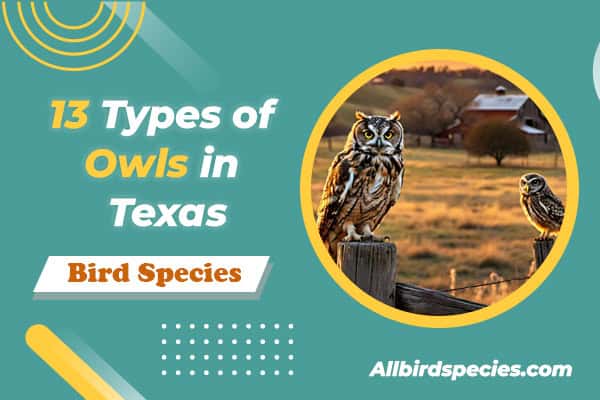8 Owls in Missouri (ID Guide With Photos)
Missouri has lots of different kinds of animals, like owls. Owls are special birds that hunt other animals for food. They’re cool because they look awesome, make interesting sounds, and are really good at hunting. In Missouri, there are 8 kinds of owls, and each one is different in how they look and sound.
Even though people like owls, they’re still a bit mysterious because they look different. In this story, we’ll learn about owls in Missouri, like where they live, what they eat, and how we can help protect them.
Whether you love watching birds or just want to learn more about nature, come with us as we discover the secrets of Missouri’s amazing owls!
Learn about 8 different types of Owls in Missouri!
1. American Barn Owl
- Scientific name: Tyto furcata
The American Barn Owl is a really cool bird that comes out at night to hunt for food. It has a special look that makes it stand out, with brown wings and a white face and belly.
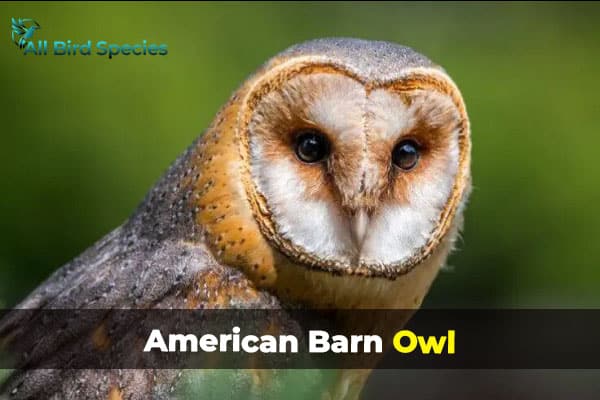
People have told stories about the American Barn Owl because it looks so unique, like it’s magical or special.
During spring and summer, these owls find a mate and build a nest together. They’re very picky about where they nest, flying around to find just the right spot.
They eat small animals like mice and shrews, using their ears to listen for them even in the dark. Sometimes they eat birds and bugs too.
Unfortunately, there aren’t as many American Barn Owls as there used to be because of chemicals that hurt the animals they eat. But they’re tough birds and can bounce back from tough times.
2. Barred Owl
- Scientific name: Strix varia
Barred Owls are birds that don’t fly far from where they live. They stick to areas close by, usually within about 6 miles. You can find them in lots of places in the eastern United States and southern Canada.

They’re easy to recognize because of their brownish-grey feathers with dark stripes underneath.
Like American Barn Owls, Barred Owls find a mate and build a nest together every year. They start looking for a mate in February and make their nests in hollow trees in thick forests.
Barred Owls mostly eat small animals like mice and birds, but sometimes they’ll eat bigger animals too. They’re really good at hearing their prey in the forests near rivers and wetlands. Sometimes they’ll even eat dead animals they find.
There are a lot of Barred Owls in North America, and they’re not in danger right now. But they could have problems in the future if their food gets contaminated or if their homes in the deep, dark forests get disturbed.
3. Long-eared Owl
- Scientific name: Asio otus
The Long-eared Owl is a bird that’s really good at hiding because its feathers look like the trees it lives in. They’re found all over the world and there are a lot of them. You can hear their spooky calls from far away in the forests they live in.
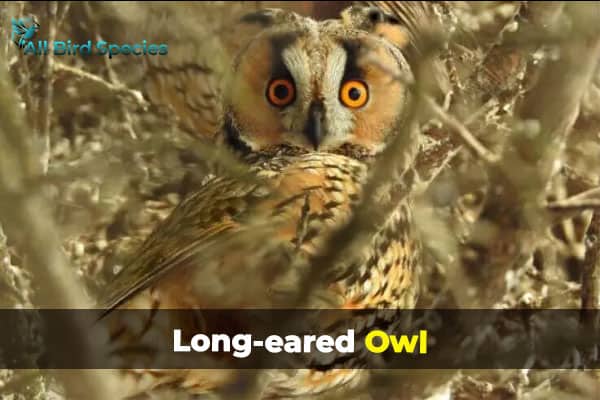
In March, Long-Eared Owls start looking for a mate and a place to nest. The males sing and flap their wings to show they’re ready, while the females look for a good spot to lay eggs. Instead of building their own nests, they use nests made by hawks or holes in tree trunks.
These owls mostly eat small animals like mice, shrews, and bugs, but sometimes they’ll eat birds too. When there’s not enough food, they might eat frogs or lizards.
They’re really good at hunting by sitting and waiting for food to come close, but they can also fly low to find food.
4. Eastern Screech-Owl
- Scientific name: Megascops asio
The Eastern Screech-Owl is a clever bird that you can find in the eastern parts of North America, even in Mexico. It’s really good at living in places where people have built things and doesn’t seem to mind all the noise we make.
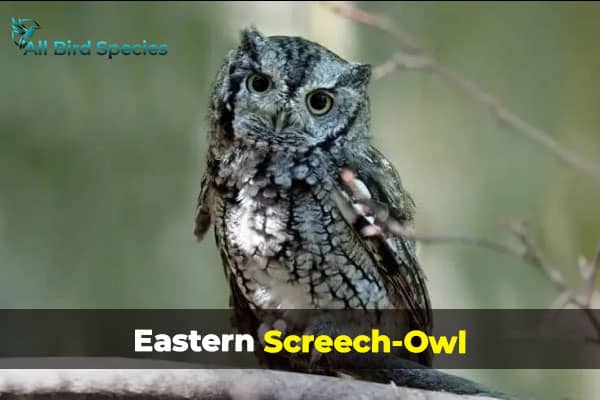
One interesting thing about this owl is that it comes in two colors – some are reddish and some are greyish. Experts think this is because of the different colors of the forests they live in.
Eastern Screech-Owls usually like to be alone, but in April, they find a partner to have babies with. They’re very loyal to their mates, but sometimes males will find another female to have babies with, which can cause some trouble.
They make their homes in holes in trees in dark forests. They eat lots of different things like mice, bugs, and even some fruits and berries. They hunt at night and use their ears to find their food. After they eat, they throw up the parts of their food that they can’t digest, like bones and feathers
5. Great Horned Owl
- Scientific name: Bubo virginianus
The Great Horned Owl is a smart bird that can live in lots of different places like deserts, wetlands, and even cities. You can find them all the way from North America to Brazil.

They’re most active at night and their feathers help them blend into their surroundings because they have brown spots. Those pointy things on their heads that look like horns are actually just feathers, but we’re not exactly sure what they’re for.
In North America, Great Horned Owls start having babies really early, sometimes as soon as January. The male owls find a good place for the babies to be born and try to impress the female owls by flying around and stomping on the ground.
They don’t make their own nests but like to use nests that other big birds like hawks or eagles have left behind. They eat different things depending on the season, like mice, rabbits, and other small animals. They hunt at night using their sharp claws and beaks to catch their food.
6. Snowy Owl
- Scientific name: Bubo scandiacus
The Snowy Owl, known for its striking white appearance, breeds in the Arctic and winters in North America. Breeding starts in April, with males performing aerial displays and presenting food to females.

Unlike other owls, they don’t build nests but scrape shallow holes for eggs. In Missouri, they primarily eat small mammals like lemmings and birds, using sharp talons for hunting. Their nomadic behavior makes population estimation challenging, but it’s believed to be decreasing due to climate change.
7. Short-eared Owl
- Scientific name: Asio flammeus
The Short-Eared Owl is a bird that you can find in many different places around the world. It’s easy to recognize because it has a small black beak and brown spots all over its body. Its wings and tail have big brown stripes.
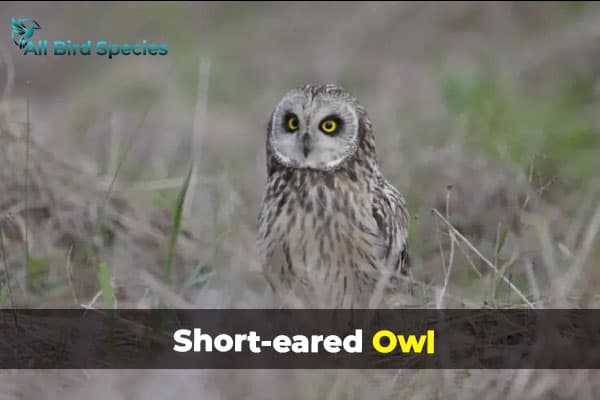
What’s special about this owl is that it hunts during the daytime, unlike most other owls.
Short-Eared Owls have a unique way of making nests. They only stay together with a mate for one breeding season, starting around March, and they like to live in groups. Instead of making nests in trees, they build their nests on the ground in places like fields and meadows.
They mostly eat small animals like mice and shrews, but they’ll also eat rabbits, insects, and even other birds. They’re really good at hunting during the day, flying low to catch their food in places like fields and grasslands.
8. Northern Saw-whet Owl
- Scientific name: Aegolius acadicus

The Northern Saw-Whet Owl, a small and elusive species, inhabits various parts of North America, including Missouri. It features a distinct appearance with a cream-colored face, brown streaks, yellow eyes, and a dark pointed beak.
Its upper body is deep brown with white spots, while its belly has light coloration with brown markings. Named after its unique call resembling a saw being sharpened, it pairs monogamously during breeding season, often nesting in existing holes.
In Missouri, it preys mainly on small mammals, insects, and birds, using sharp talons and beaks for hunting, even capturing larger prey.
Check Our Previous Articles
| Squirrels That Found In California |
| Birds Found in Spain |
| Red Headed Birds of Hawaii |
| Birds With Orange Heads |
Frequently Asked Questions About Owls in Missouri
Q1: What owl is common in Missouri?
The most common owl in Missouri is the Eastern Screech Owl.
Q2: Does Missouri have burrowing owls?
No, Missouri does not have burrowing owls.
Q3: Where do most owls live in the US?
Most owls in the US live in forests, woodlands, and grasslands.
Q4: What is the most common owl to see?
The most common owl to see in the US is the Great Horned Owl.




